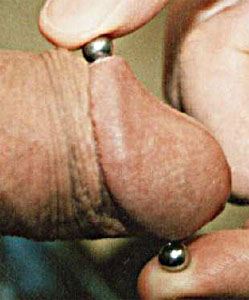Shaft ampallang and Shaft apadravya: Difference between pages
(Difference between pages)
Jump to navigation
Jump to search
(Page conversion via llm-mediawiki-rev -jwm) |
(Page conversion via llm-mediawiki-rev -jwm) |
||
| Line 1: | Line 1: | ||
[[File:ShaftApadravya.jpg|right|thumb|250px|]] | |||
An [[apadravya]] pierced through the shaft of the [[penis]]. | |||
Most apadravyas are pierced through the glans itself, but it is plausible to perform them through the shaft as well. Usually, the '''shaft apadravya''' piercing is done immediately behind the glans, but they have been pierced as far back as the base of the penis. It is largely urban legend that this piercing carries with it the risk of massive bleeding or nerve damage. | |||
Latest revision as of 11:18, 17 September 2023
An apadravya pierced through the shaft of the penis.
Most apadravyas are pierced through the glans itself, but it is plausible to perform them through the shaft as well. Usually, the shaft apadravya piercing is done immediately behind the glans, but they have been pierced as far back as the base of the penis. It is largely urban legend that this piercing carries with it the risk of massive bleeding or nerve damage.
